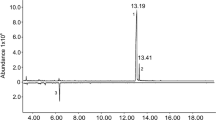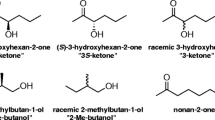Abstract
The citrus borer, Diploschema rotundicolle, is a Neotropical longhorn beetle that has become a serious citrus pest in southern South America. Management strategies for this insect rely on trimming off damaged shoots, which is expensive and inefficient. We studied the chemical communication system in D. rotundicolle in search of attractants for monitoring or control. GC-MS and enantioselective GC analyses of volatile extracts from field-collected adults showed that males produce (R)-3-hydroxy-2-hexanone, irregularly accompanied by minor amounts of 2,3-hexanediol (all four stereoisomers) and 2,3-hexanedione. Males emit the compounds only at night, when the adults are active. GC-EAD analyses of natural and synthetic compounds showed that both male and female antennae respond to the natural enantiomer (R)-3-hydroxy-2-hexanone, suggesting that it may function as an aggregation-sex pheromone as seen in many cerambycines. The non-natural (S) enantiomer as well as the minor component 2,3-hexanediol did not trigger antennal responses. Field tests with the racemic 3-hydroxy-2-hexanone, enantiomerically pure (R)-3-hydroxy-2-hexanone, as well as a mixture of racemic 3-hydroxy-2-hexanone and 2,3-hexanediol, showed in all cases low capture levels of D. rotundicolle. However, increasing the elevation of the trap and the emission rate of dispensers enhanced field captures in traps baited with racemic hydroxyketone. Incidental catches of another native cerambycine, Retrachydes thoracicus, in traps baited with 3-hydroxy-2-hexanone are also reported. This is the first report of pheromone chemistry in the genus Diploschema and in the tribe Torneutini, reaffirming the pheromone parsimony well established for the Cerambycinae. Potential factors explaining the weak attraction of D. rotundicolle in the field are discussed.





Similar content being viewed by others
References
Allison JD, Bhandari BD, McKenney JL, Millar JG (2014) Design factors that influence the performance of flight intercept traps for the capture of longhorned beetles (Coleoptera: Cerambycidae) from the subfamilies Lamiinae and Cerambycinae. PLoS One 9(3):e93203. https://doi.org/10.1371/journal.pone.0093203
Barbour JD, Alston DG, Walsh DB, Pace M, Hanks LM (2019) Mating disruption for managing Prionus californicus (Coleoptera: Cerambycidae) in hop and sweet cherry. J Econ Entomol 112:1130–1137. https://doi.org/10.1093/jee/toy430
Bates D, Maechler M, Bolker B, Walker S (2015) Fitting linear mixed-effects models using lme4. J Stat Softw 67(1):1–48. https://doi.org/10.18637/jss.v067.i01
Bentancourt CM, Scatoni IB (1999) Guía de insectos y ácaros de importancia agrícola y forestal en el Uruguay, 3rd edn. Editorial Hemisferio Sur, Montevideo
Di Rienzo JA, Casanoves F, Balzarini MG, Gonzalez L, Tablada M, Robledo CW (2011) InfoStat versión 2011. Grupo InfoStat, FCA, Universidad Nacional de Córdoba, Argentina. http://www.infostat.com.ar
Fan J, Denux O, Courtin C, Bernard A, Javal M, Millar JG, Hanks LM, Roques A (2018) Multi-component blends for trapping native and exotic longhorn beetles at potential points-of-entry and in forests. J Pest Sci 92:281–297. https://doi.org/10.1007/s10340-018-0997-6
Faria AM, Fernandes SCS, dos Santos JCC, Bergmann E, Brisolla AD, Takematsu AD, Negri JD, y Sempinoato OR (1987) Estudo sobre controle da broca-dos ramos e do tronco dos citros Diploschema rotundicolle (Serville, 1834) (Coleoptera - Cerambycidae). Biologico, Sao Paulo 53:13–18
Graham EE, Mitchell RF, Reagel PF, Barbour JD, Millar JG, Hanks LM (2010) Treating panel traps with a fluoropolymer enhances their efficiency in capturing cerambycid beetles. J Econ Entomol 103:641–647
Graham EE, Poland TM, Millar JG (2012) A comparison of trap type and height for capturing cerambycid beetles (Coleoptera). J Econ Entomol 105:837–846. https://doi.org/10.1603/EC12053
Hanks LM, Millar JG (2016) Sex and aggregation-sex pheromones of cerambycid beetles: basic science and practical applications. J Chem Ecol 42:631–654. https://doi.org/10.1007/s10886-016-0733-8
Hanks LM, Mongold-Diers JA, Atkinson TH, Fierke MK, Ginzel MD, Graham EE, Poland TM, Richards AB, Richardson ML, Millar JG (2018) Blends of pheromones, with and without host plant volatiles, can attract multiple species of cerambycid beetles simultaneously. J Econ Entomol 111:716–724. https://doi.org/10.1093/jee/tox373
Hansen L, Xu T, Wickham J, Chen Y, Hao D, Hanks LM, Millar JG, Teale SA (2015a) Identification of a male-produced pheromone component of the citrus longhorned beetle, Anoplophora chinensis. PLoS One 10(8):e0134358. https://doi.org/10.1371/journal.pone.0134358
Hansen L, Xu T, Wickham J, Chen Y, Hao D, Hanks LM, Millar JG, Teale SA (2015b) Identification of a male-produced pheromone component of the citrus longhorned beetle, Anoplophora chinensis. PLoS One 10:e0134358
Heguaburu V, do Carmo H, Parpal F, Amorós ME, González A (2017) Synthesis of aggregation pheromone components of cerambycid species through α-hydroxylation of alkylketones. Tetrahedron Lett 58:1738–1741
Hothorn T, Bretz F, Westfall P (2008) Simultaneous inference in general parametric models. Biom J 50:346–363. https://doi.org/10.1002/bimj.200810425
Link D, Corrêa Costa E (1994) Nível de infestação da broca dos citros, Diploschema rotundicolle (Serville, 1834) em cinamomo e plantas cítricas, em Santa Maria - RS. Cienc Rural 24(1):7–10. https://doi.org/10.1590/S0103-84781994000100002
Machado LA, Berti Filho EB (2006) Prática cultural associada ao controle biológico com o fungo Metarhizium anisopliae no combate à broca-dos-citros Diploschema rotundicolle. Arquivos do Instituto Biológico, São Paulo 73:439–445
Machado LA, Filho B (1999) Criação artificial da broca-dos-citros Diploschema rotundicolle (Serville, 1834) (Col.: Cerambycidae) Biológico, São Paulo 61:5–11
Machado LA, Cruz BPB, Leite LG, Batista Filho A, da Silva EM (1991) Práticas para o controle da broca-dos citros, Diploschema rotundicolle (Serville, 1834) (Coleoptera: Cerambycidae). In: XIII Congresso Brasileiro de Entomologia, Sociedade Entomologica do Brasil, Recife, PE, p 313
Maki EC, Millar JG, Rodstein J, Hanks LM, Barbour JD (2011) Evaluation of mass trapping and mating disruption for managing Prionus californicus (Coleoptera: Cerambycidae) in hop production yards. J Econ Entomol 104:933–938
Millar JG, Hanks LM (2018) New pheromones for invasive cerambycids: from the bench to the field. In: proceedings of the 29th USDA interagency research forum on invasive species, Annapolis, MD
Mitchell RF, Millar JG, Hanks LM (2013) Blends of (R)-3-hydroxyhexan-2-one and alkan-2-ones identified as potential pheromones produced by three species of cerambycid beetles. Chemoecology 23:121–127
Mitchell RF, Reagel PF, Wong JC et al (2015) Cerambycid beetle species with similar pheromones are segregated by phenology andminor pheromone components. J Chem Ecol 41(5):431–440. https://doi.org/10.1007/s10886-015-0571-0
Monné M (2018) Catalogue of the Cerambycidae (Coleoptera) of the Neotropical region. Part I. Subfamily Cerambycinae. https://www.biotaxa.org/Zootaxa/article/view/zootaxa.946.1.1. Accessed July 2019
R Core Team (2018) R: a language and environment for statistical computing. R Foundation for Statistical Computing, Vienna https://www.R-project.org
Sanchez-Husillos E, Etxebeste I, Pajares J (2015) Effectiveness of mass trapping in the reduction of Monochamus galloprovincialis Olivier (Col.: Cerambycidae) populations. J Appl Entomol 139:747–758
Schmeelk TC, Millar JG, Hanks LM (2016) Influence of trap height and bait type on abundance and species diversity of cerambycid beetles captured in forests of east-Central Illinois. J Econ Entomol 109:1750–1757
Schröder F, Fettköther R, Noldt U, Dettner K, König WA, Francke W (1994) Synthesis of (3R)-3-hydroxy-2-hexanone, (2R,3R)-2,3-hexanediol and (2S,3R)-2,3-hexanediol, the male sex pheromone of Hylotrupes bajulus and Pyrrhidium sanguineum (Cerambycidae). Liebigs Ann Chem 1994:1211–1218. https://doi.org/10.1002/jlac.199419941212
Shanley RP, Keena M, Wheeler MM, Leland J, Hajek AE (2009) Evaluating the virulence and longevity of non-woven fiber bands impregnated with Metarhizium anisopliae against the Asian longhorned beetle, Anoplophora glabripennis (Coleoptera: Cerambycidae). Biol Control 50:94–102
Silva WD, Zou Y, Bento JMS, Hanks LM, Millar JG (2017) Aggregation-sex pheromones and likely pheromones of 11 south American cerambycid beetles, and partitioning of pheromone channels front. Ecol Evol 5:1–9
Silva WD, Millar JG, Hanks LM, Costa CM, Leite MOG, Tonelli M, Bento JMS (2018) Interspecific cross-attraction between the south American cerambycid beetles Cotyclytus curvatus and Megacyllene acuta is averted by minor pheromone components. J Chem Ecol 44:268–275. https://doi.org/10.1007/s10886-018-0933-5
Acknowledgments
We would like to thank the citrus companies San Miguel Global and Agrisur-Urudor for granting financial support and access to their groves. Additional financial support from CSIC (Comisión Sectorial de Investigación Científica from Universidad de la República) and PEDECIBA (Programa para el Desarrollo de las Ciencias Básicas, Uruguay) are also acknowledged. We would also like to thank Alejandro Borges, Marcelo Saavedra, Yamandú Pochintesta, Martín Lanfranco, Gabriela Asplanato, Carmen Rossini, Diana Valle, Anna Paula Burgueño, Federico Rodrigo, María Laura Umpiérrez, Valentina Ocampo and Paula Altesor for various contributions. Chemical standards provided by Jocelyn G. Millar and valuable advice by Lawrence Hanks are much appreciated.
Author information
Authors and Affiliations
Corresponding authors
Electronic supplementary material
ESM 1
(DOCX 277 kb)
Rights and permissions
About this article
Cite this article
Amorós, M.E., Lagarde, L., Carmo, H.D. et al. Pheromone Chemistry of the Citrus Borer, Diploschema rotundicolle (Coleoptera: Cerambycidae). J Chem Ecol 46, 809–819 (2020). https://doi.org/10.1007/s10886-020-01203-4
Received:
Revised:
Accepted:
Published:
Issue Date:
DOI: https://doi.org/10.1007/s10886-020-01203-4




